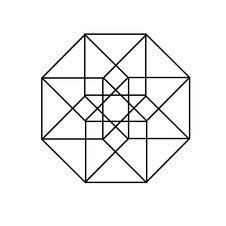
A tesseract is a 4-dimensional hypercube. Since the number of dimensions is a square number, the diagonal length of a tesseract is an integer - in this case, 2. Its Bowers acronym is "tes". The image shows the shadow of a rotating tesseract, keep in mind that 4D objects have 3D shadows.
Variants[]
The tesseract can be seen as a cube prism, the product of a cube and a line segment. It is also the square-square duoprism, i.e. the product of two squares. It can also be seen as a square prism prism, or the product of four line segments.
Structure and sections[]
The tesseract is composed of eight cubic cells. Two of these cubes line in parallel 3-D spaces, while the remaining six connect the faces of the cubes. Four cubes meet at each vertex.
In cube-first position, it is a sequence of identical cubes. In square-centered orientation, it is a square which expands to a square prism and back. When seen line-first it is a line that expands to a triangular prism, then turns to a hexagonal prism, and then back. Finally in corner first orientation, it goes through the entire tetrahedral truncation series, from point to tetrahedron to octahedron in the middle and then back.
| Zeroth | First | Second | Third | Fourth | Fifth | Sixth | Seventh | Eighth | Ninth | Tenth | |
|---|---|---|---|---|---|---|---|---|---|---|---|
| Simplex | Point | Line | Triangle | Tetrahedron | Pentachoron | Hexateron | Heptapeton | Octaexon | Enneazetton | Decayotton | Hendecaxennon |
| Hypercube | Point | Line | Square | Cube | Tesseract | Penteract | Hexeract | Hepteract | Octeract | Enneract | Dekeract |
| Cross | Point | Line | Square | Octahedron | Hexadecachoron | Pentarss | Hexarss | Heptarss | Octarss | Ennearss | Decarss |
| Hypersphere | Point | Line | Circle | Sphere | Glome | Hyperglome | Hexaphere | Heptaphere | Octaphere | Enneaphere | Decaphere |
